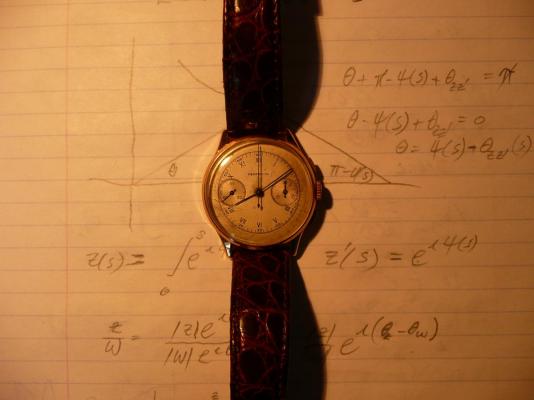Search the Community
Showing results for tags 'physics'.
-
Here's picture of a WWII vintage chronograph I obtained c.1975. I think I paid $35 for it then--certainly less than $50. I actually wore it as a daily watch for many years. Then it started to run erratically so I put it in a drawer and let it "sleep" for about 10 years. In the late 90's I took it to a watchmaker in Chicago who said it could be restored, but it would cost! Even then something inside me--akin to a doctor's impulse to heal--wanted this watch to live. Besides, it has a nice rose gold case with the inscription "To Sid from Hank 1945 - 1946" on the back. So I let him do the work. It keeps great time. I'm not familiar with the Perfecta brand and I don't know who made the movement (anyone know about them?). The dial and hands are original. Please forgive the background! But part of the appeal of watchmaking is the theory behind horology. I've been working on the hairspring starting from a paper by S. Goudsmit and Ming-Chen Wan, Introduction to the Problem of the Isochronous Hairspring in the Journal of Applied Physics (December 1940). I tried working out the physics myself but without much success. The physics of the Archimedes Spiral is--one might say--non-trivial. There is at least one recent book out there which purports to work out the theory but it's really expensive. I also have Charles Edgar Fritts book, The Balance Spring. It's very complete and has a lot of practical information but its kind of densely written--requiring a lot of close study--but no mathematics. Moreover it requires an understanding of some of its figures and I've never been good at (actually patient with) drawings, especially 19th century drawings. (Can anyone explain to me Fig. 4?) I'm fascinated with the idea of building a computer program that would locate graphically the point where a hairspring could be vibrated. My impression is that experienced watchmakers can often get very close by visual inspection, but for beginners like myself it would be very helpful if we could see such points for a lot of different hairsprings. So, I've been using Mathematica along with its graphical processing functions to work from pictures of hairsprings. Once I know the spring constant it should be possible, using the physics of the spiral, to work out such points mathematically--numerically, at least. It goes like this: first, take a picture of your hairspring against a background of some standard hue. Then use graphical processing to pull out the pixels of the hairspring, assign them coordinates, fitting them to a mathematical spiral and use the theory to locate the vibration point, which can then be plotted on the same picture. That's the plan anyway but it may not be possible for reasons I haven't yet understood.
- 6 replies
-
- Perfecta
- hairspring
-
(and 1 more)
Tagged with:


